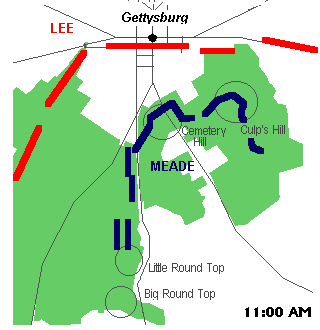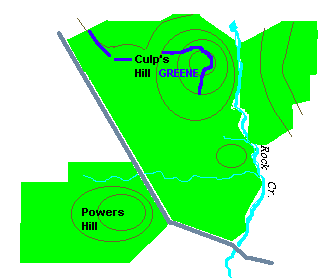Gettysburg: July 2, 1863- "A most terrible day..."

|
| Lee attacked late in the afternoon, striking both flanks of the Union position. The fighting raged until after nightfall. |
The Bloodiest Day of the Battle.
By the morning of July 2, the Union army had established strong positions along a giant U-shaped line from Culp's Hill to Cemetery Ridge. Satisfied with this position, General Meade decided to wait while the remainder of the Army of the Potomac hurried to the battlefield. From Seminary Ridge, General Lee studied the distant Union position. Though the Union right flank appeared to be a difficult position to attack, the left flank did not appear to be anchored on any significant feature. Simultaneous attacks on both the right and left flanks could roll up the Union line toward Cemetery Hill. Lee directed General A.P. Hill to continue to hold the Confederate center while General James Longstreet's Corps would attack the Union left and General Ewell's Corps would attack the right. Both had to strike at the same time to throw the Union off balance, not giving Meade time to shift troops to the threatened areas.
Situated on the left of the Union line was the Third Army Corps under the command of Major General Daniel E. Sickles, an audacious and sometimes belligerent commander. Unhappy with the location assigned him and finding that Confederates were massed on Seminary Ridge almost a mile in his front, Sickles ordered his corps to advance away from the main Union line on Cemetery Ridge and occupy high ground on the Emmitsburg Road, midway between Cemetery Ridge and Seminary Ridge. In doing so, Sickles' unknowingly made Meade's established line vulnerable. Meanwhile, General Longstreet's column finally reached the southern tip of Seminary Ridge at 3:30 PM after an exhausting 18 mile march. The Confederates deployed along the ridge through Pitzer's Woods and south along Warfield Ridge. The men only had a few moments to rest and search for water before they were called into line and the attack began.
At 4 PM, Confederate cannoneers opened fire on Sickles' line from Devil's Den to the Peach Orchard. Confederates under General John Bell Hood swung eastward toward Devil's Den while fighting erupted in the Wheatfield, at the Peach Orchard and on the slopes of Little Round Top. Bravery and gallantry saved Little Round Top, a key feature on the southern end of the Union line, but Union troops could not hold Devil's Den and the adjoining area, later known as the "Valley of Death". Nearby was the Wheatfield, where soldiers who fought there compared it to a "whirlpool" of tides and eddies that continually swept around the field. Over 6,000 officers and men from both armies were killed, wounded or captured in charge and counter-charge across that field and in the woods surrounding it. Fighting spread to the Peach Orchard, along the Emmitsburg Road, and up Cemetery Ridge. At the height of the attack, General Sickles was seriously wounded while near his headquarters. Carried from the battlefield on a stretcher, the general inspired those passing by him with encouraging words and wave of his hat.
At approximately 6:30, General McLaws sent forward his Mississippi brigade commanded by Brig. General William Barksdale, who had waited impatiently with his men at Pitzer's Woods. The Mississippi attack rammed through Union regiments near the Peach Orchard and other Confederate units rushed from Seminary Ridge to exploit the break. The battered Union line wavered and slowly collapsed under the relentless Confederate pressure that swept across the Abraham Trostle Farm at the center of Sickles' line. Here the southerners found themselves at the doorway of a sizeable gap in the Union line between Cemetery Hill and Little Round Top, held by a handful of Union artillerymen and one regiment of foot soldiers, the 1st Minnesota Infantry. The Minnesota regiment was about to do the impossible- stop the Confederate attack before they reached the center of Cemetery Ridge. The Minnesotans charged into the Confederates and succeeded in slowing their attack, but at a terrible cost. Union reinforcements arrived and drove the Confederates back, but not before they had threatened the Union line right up to its center.
Darkness put a grateful end to the slaughter and Meade used the lull to shore up the left with fresh troops. By 10 PM, the line had been reestablished on Cemetery Ridge and extended to Big Round Top, where Union troops built stone barricades up to its summit. Exhausted soldiers reformed behind stone walls and laid down for the evening, disturbed only by groans from thousands of wounded men on the battlefield or the occasional crack of a rifle.
The Battle For Culp's & Cemetery Hills
 In cooperation with Longstreet's attack on the Union left, General Ewell opened his cannonade on the Union right flank at 4 o'clock, but an overwhelming response of Union artillery from Cemetery Hill delayed the infantry assault, designed to first strike Culp's Hill, the strong point of the Union right. Confederate infantrymen under General Edward Johnson encountered numerous difficulties getting into position and night had fallen by the time his men splashed across Rock Creek to climb the hill's wooded slopes. Suddenly they were struck by accurate and deadly Union rifle fire delivered by a single brigade of New York troops under Brig. General George S. Greene. Johnson's men scattered for cover though a portion of his force discovered abandoned earthworks above Spangler's Spring. Confused by the Union defense and believing that he was heavily outnumbered, Johnson decided to halt his attack to wait for reinforcements and then renew his assault the next morning.
In cooperation with Longstreet's attack on the Union left, General Ewell opened his cannonade on the Union right flank at 4 o'clock, but an overwhelming response of Union artillery from Cemetery Hill delayed the infantry assault, designed to first strike Culp's Hill, the strong point of the Union right. Confederate infantrymen under General Edward Johnson encountered numerous difficulties getting into position and night had fallen by the time his men splashed across Rock Creek to climb the hill's wooded slopes. Suddenly they were struck by accurate and deadly Union rifle fire delivered by a single brigade of New York troops under Brig. General George S. Greene. Johnson's men scattered for cover though a portion of his force discovered abandoned earthworks above Spangler's Spring. Confused by the Union defense and believing that he was heavily outnumbered, Johnson decided to halt his attack to wait for reinforcements and then renew his assault the next morning.
Northwest of Culp's Hill, two Confederate brigades under General Jubal Early momentarily penetrated the Union defenses at Cemetery Hill. In the gathering gloom of dusk, "Louisiana Tigers" and North Carolina soldiers overran Union troops on the eastern side of the hill and rushed through to the summit into Union batteries stationed there. Union reinforcements rushed to the scene and immediately attacked with rifles and bayonets, throwing the Confederates off Cemetery Hill for good.
Union troops of the Twelfth Army Corps, pulled away from Culp's Hill on July 2, returned the following morning and attacked Johnson's troops before they could begin their attack. The roar of musketry was deafening. From the summit of the hill to the meadow near Spangler's Spring, combatants kept up a constant stream of rifle fire, showered all the while with leaves and branches cut from trees by bullets and shells. Unable to break the Union stranglehold on Culp's Hill, Johnson finally withdrew after six hours of continuous fighting, leaving the slopes covered with dead and wounded. By 11 AM on July 3, the southern threat at Culp's Hill had ended.
Late into the night, both army commanders evaluated the results of a long and brutal day. Apart from the precious foothold on Culp's Hill, the Confederate gamble of simultaneous attacks had failed. Knowing that he could not sustain more than another full day of battle, a frustrated Lee was working at his headquarters when a smiling General "JEB" Stuart arrived. The smile quickly vanished when the disgusted army commander admonished Stuart for his long absence and failure to report Union movements in the weeks prior to the battle. Yet it was quickly back to the business at hand for Stuart's cavalry would fit prominently into Lee's strategy for the next day of battle. Meanwhile, General Meade held a "Council of War" at his headquarters on the Taneytown Road. Though the Union line had been restored by midnight there was still a sizeable Confederate force on Culp's Hill. Almost to a man, his generals agreed to stay at Gettysburg, retake and secure Culp's Hill, and then wait for Lee to attack. If he did not, then Meade should order a counterattack and force Lee to fight or flee. The Gettysburg Campaign was about to reach its climax.